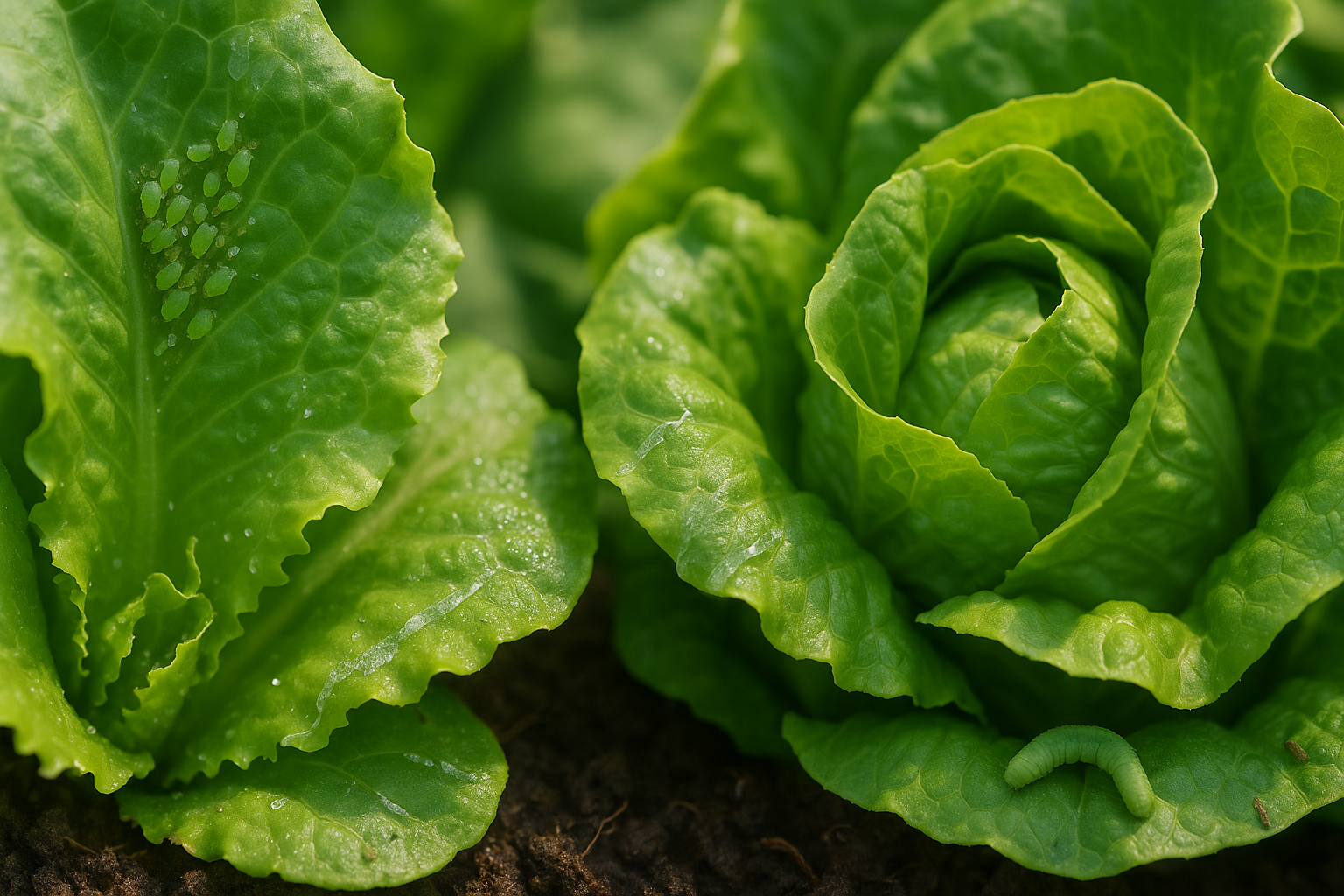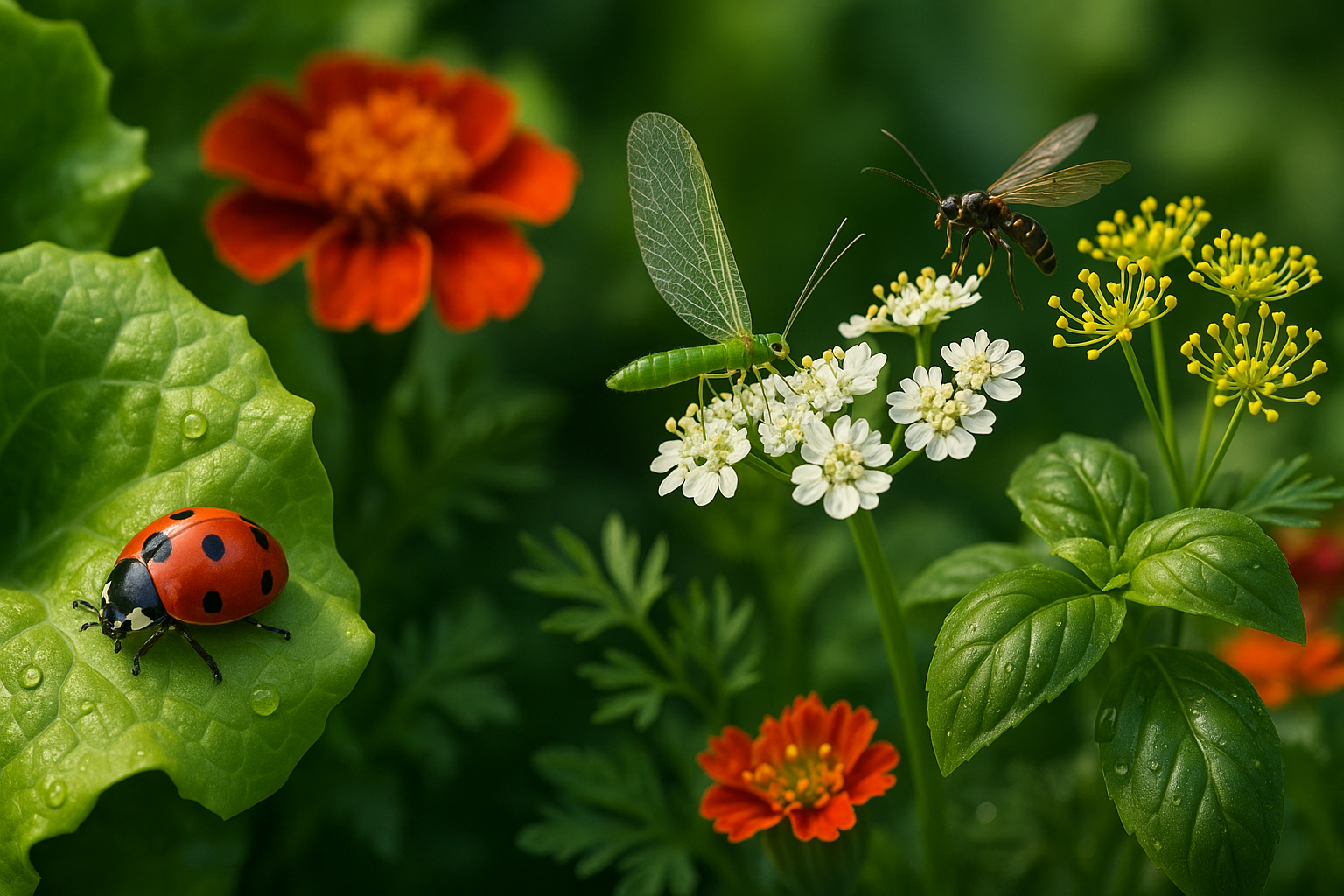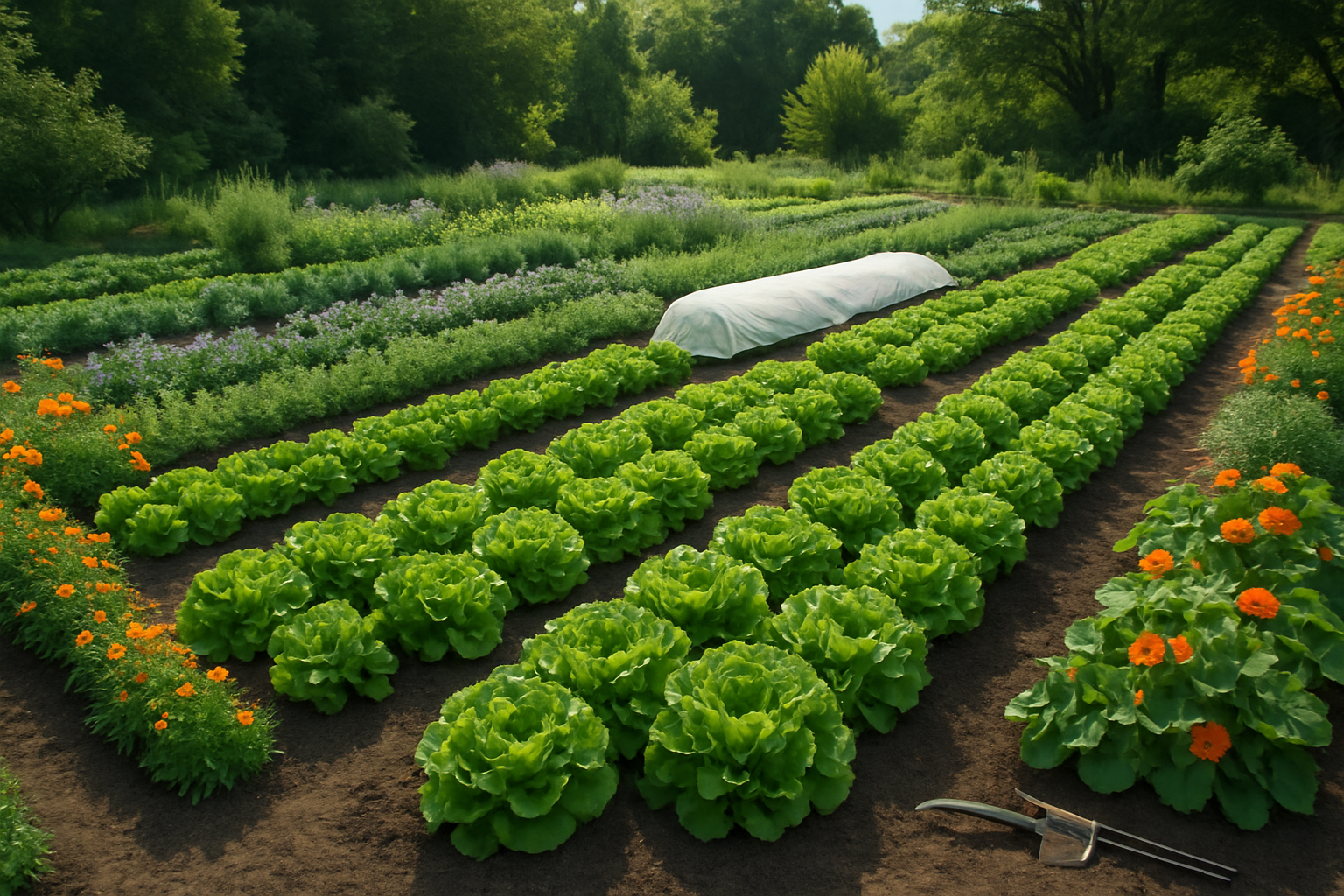Introduction to Natural Pest Control for Organic Lettuce Farmers
Organic lettuce pest control is one of the biggest challenges faced by growers committed to keeping their farms chemical-free. If you’ve ever lost a crop to aphids, caterpillars, or slugs, you know how quickly a lettuce patch can turn into an all-you-can-eat buffet for insects.
But relying on synthetic pesticides can jeopardize the quality of your greens and the health of your soil—not to mention your customers’ trust and the local ecosystem. That’s why many successful lettuce farmers turn to natural, sustainable methods for organic lettuce pest control.
These approaches, such as introducing beneficial insects, using floating row covers, or encouraging soil biodiversity, are not only safe but often more effective in the long run than synthetic chemicals. This blog post will explore practical, real-world natural pest control strategies—helping you protect your lettuce from common pests, boost your harvest, and promote ecological balance on your farm.
By choosing science-backed, earth-friendly solutions, you can cultivate thriving lettuce yields while preserving the integrity of your soil and surrounding environment. Let’s dig into the best practices that keep both your lettuce and the planet healthy.
Understanding Common Pests Affecting Organic Lettuce

Growing organic lettuce comes with its share of pest challenges, with aphids, slugs, and caterpillars being some of the most frequent culprits. Aphids are tiny, soft-bodied insects that cluster on the undersides of leaves and along tender stems. If you notice lettuce leaves curling, yellowing, or feeling sticky, aphids are likely the cause—the sticky substance is known as honeydew, which also attracts ants.
Slugs leave telltale silvery slime trails, irregularly shaped holes, and ragged edges on lettuce, mostly feeding at night or after rain. Meanwhile, caterpillars, particularly the larvae of moths and butterflies like cabbage loopers, chew large, round holes in the foliage and sometimes hide in the lettuce head, making them tough to spot at first glance.
Other pests to watch for include flea beetles, which produce tiny “shot holes” in leaves, and root maggots that can stunt plant growth from below the soil.
Pest Activity and Environmental Factors
Pest pressures typically peak during warm, damp conditions—aphids flourish in the mild temperatures of spring and early summer, while slugs are more active during wet or humid weather common in coastal or rainy regions. Even your garden’s microclimate can play a role; if you’re in a cooler northern area, certain pests may emerge later and persist longer than in warmer southern zones.
Preventive Measures and Control
Scouting your lettuce patch regularly for holes, slime, or clusters of insects is essential, as early identification means you can take action before major damage sets in. Encouraging beneficial insects like ladybugs, using row covers, and ensuring good garden hygiene are smart organic strategies to help keep these pests under control, no matter the season or location.
Prevention-First
One of the most effective ways to keep pests at bay is to focus on prevention, making your garden a place they simply don’t want to call home. Start with robust cultural practices like crop rotation—changing what you plant in each spot every year disrupts the life cycles of soil-borne pests and diseases. This is especially helpful for common problem plants like tomatoes, potatoes, and brassicas, which can attract the same pests year after year if left in the same place.
Healthy soil is a critical line of defense, too. Regularly adding compost or well-rotted manure boosts beneficial microbes and helps plants grow strong, making them less vulnerable to pest damage. Interplanting, or mixing different types of crops together, can also confuse pests and make it harder for them to find their favorite foods. For example, planting aromatic herbs like basil or marigolds among vegetables often repels pests like aphids and beetles.
Physical barriers are another smart tactic—lightweight mesh or floating row covers keep flying insects from laying eggs, while mulching with straw or bark not only suppresses weeds but also deters crawling pests like slugs. For fruit crops, simple netting can block hungry birds and larger insects.
Garden hygiene finishes out your prevention plan: remove dead leaves, fallen fruit, and spent crops regularly, as these can harbor pests over winter. Avoid leaving dense weeds or plant debris alongside garden beds, since they offer perfect hiding spots. Even cleaning your tools between uses prevents the accidental spread of pathogens or pest eggs.
By layering these prevention-first strategies, you create an environment where pest problems have little room to start—and where your crops can thrive with much less effort, reducing the need for chemical interventions.
Natural and Biological Pest Control Methods

When it comes to safe and effective pest control, natural and biological methods can make a real difference in keeping your garden healthy without relying on harsh chemicals. One of the most powerful strategies is to introduce or attract beneficial insects that act as nature’s pest patrol.
Ladybugs, for example, have a big appetite for aphids, while lacewings and their larvae gobble up soft-bodied pests. Parasitic wasps can target and neutralize caterpillars or whiteflies by laying their eggs inside pest larvae. To get these tiny helpers working in your favor, try growing nectar-rich flowers such as dill, fennel, and yarrow that provide food and habitat, or purchase live beneficial insects from reputable garden suppliers to release in problem areas.
Alongside beneficial insects, organic sprays offer another layer of defense: simple soapy water (just a small amount of mild liquid soap in water) can knock down aphids, spider mites, and whiteflies without harming plants. Neem oil, derived from the neem tree, disrupts the life cycle of many pests and is safe for most beneficial insects when applied carefully.
If you prefer hands-on control, physical methods like hand-picking beetles, caterpillars, or slugs, or blasting aphids from leaves using a strong stream of water, are simple and surprisingly effective for smaller infestations. For extra protection, floating row covers and fine-mesh netting can act as barriers to block out flying insect pests.
Companion planting is another smart, natural technique that works by pairing certain plants to repel bugs or mask scent trails. For example:
- Marigolds are known to deter nematodes and beetles when planted near vegetables.
- Aromatic herbs like basil and rosemary can confuse and repel flies and mosquitoes.
- Planting onions or garlic near susceptible crops often minimizes attacks from pests like carrot flies and aphids.
By combining these methods—encouraging beneficial insects, using homemade or approved organic sprays, taking direct physical action, and incorporating strategic plant partnerships—you can cultivate a thriving, resilient garden that naturally keeps pests in check without synthetic pesticides. The key is to observe regularly, act early, and layer your control methods for the healthiest plants and harvests.
When to Intervene

Knowing when to intervene in your garden or landscape is crucial for maintaining healthy plants while minimizing chemical use. Not every pest calls for immediate action—this is where the concept of a threshold comes in. Thresholds refer to the pest levels you can tolerate before the damage outweighs the benefits of letting nature take its course.
For example, a few aphids on roses rarely justify spraying, but if they start covering entire stems and blooms, intervention becomes necessary. To identify these moments, regular monitoring and scouting are essential. Walk through your garden weekly, flip over leaves, and watch for early signs of infestations or plant stress. Use visual counts, sticky traps, or even smartphone photos to track pest numbers over time.
When you notice pest levels approaching your threshold, opt for selective spot treatments instead of broad applications. This might mean hand-picking caterpillars from a tomato plant or targeting a small aphid cluster with insecticidal soap rather than treating the whole garden.
Whenever possible, favor methods that conserve natural predators like ladybugs, lacewings, and parasitic wasps—these beneficial insects form the foundation of a balanced ecosystem and often keep pests in check naturally. Limit interventions to truly necessary cases; overreacting can disrupt this balance and encourage recurring pest issues.
By staying observant and acting only when thresholds are crossed, you can maintain healthier plants, reduce pesticide use, and support a thriving, biodiverse garden.
Dealing with Recurring or Severe Pest Problems
Facing recurring or severe pest problems can be frustrating, but a strategic, multi-step approach can help restore balance to your garden or farm. Start by identifying the specific pest and the extent of the infestation—take notes or photos, and observe patterns.
Rotate your control methods to prevent pests from building resistance; for example, combine hand-picking or traps with natural predators, organic sprays, and physical barriers like row covers. Healthy soil leads to resilient plants, so regularly add compost or well-rotted manure to boost microbial life, and avoid over-fertilizing, as this can attract certain pests.
Consider adjusting your planting schedules; for instance, planting slightly earlier or later than usual can help outmaneuver peak pest populations. Growing pest-resistant varieties or interplanting with species that repel bugs—such as basil with tomatoes or marigolds among vegetables—offers added protection.
Crop rotation is crucial if you’re dealing with soil-borne pests; change planting locations each season to disrupt pest life cycles. For stubborn problems, keep records of what works and what doesn’t, since this insight can inform quick action in future seasons.
If home strategies aren’t enough, reach out to your local extension service or nearby organic farming organizations. These resources offer region-specific advice, pest identification assistance, and up-to-date recommendations suited to your climate and crops. Don’t hesitate to ask for help; tapping into local expertise often saves time, money, and frustration while promoting more sustainable, long-term pest management.
Sustaining Organic Lettuce Production Long-term

Integrated pest management (IPM) offers a holistic and sustainable way to keep pests in check for long-term organic lettuce production. By combining preventative measures—like crop rotation, planting pest-resistant lettuce varieties, and encouraging beneficial insects—with careful, targeted interventions, farmers can reduce the need for harsh chemicals while maintaining healthy crops.
For example, introducing ladybugs to control aphids or using physical barriers like row covers can make a significant difference. Regular crop scouting is vital: look for early signs of damage, unusual plant growth, or increases in pest populations.
One practical tip is to keep a simple notebook or digital log to track pest outbreaks, treatments applied, weather conditions, and crop health; over time, this helps spot trends and fine-tune your management strategies. These records become invaluable tools, guiding decision-making from season to season.
Remember, organic farming is a journey that rewards patience, observation, and adaptability. The most successful growers are those who remain curious, learn from each season, and view challenges as opportunities to improve.
By prioritizing ecological stewardship—working with nature rather than against it—you’ll not only ensure more resilient lettuce crops but also contribute to a healthier farm ecosystem for years to come. Stay motivated, embrace continuous learning, and trust that your commitment to these sustainable practices truly matters.
